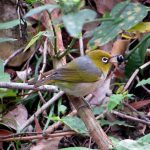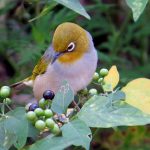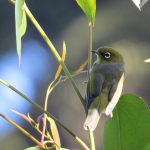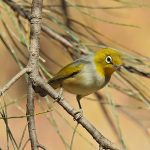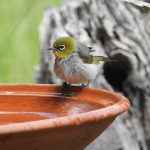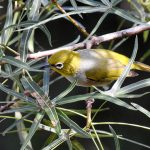SILVEREYE
With its distinctive white eye-ring, olive-green back, and soft grey underparts, the Silvereye is a visual treat and an embodiment of nature’s resilience.
The Silvereye is a testament to the tenacity of life. These birds have a lifespan that typically ranges from 5 to 10 years, a remarkable feat for such a small creature. Their longevity is partly due to their adaptable nature and varied diet, which includes nectar, fruits, and small insects. This diverse menu allows them to thrive in a variety of habitats, from dense forests to urban gardens.
The Silvereye’s habitat preference is as varied as the Australian landscape itself. Originally forest dwellers, they have shown remarkable adaptability by spreading to a wide range of environments. You can find these birds in forests, woodlands, shrublands, and even in urban areas where gardens are abundant. Their ability to thrive in various habitats is a testament to their resilience and versatility.
During the year, Silvereyes undertake a fascinating migration journey. Populations in the cooler southern regions of Australia migrate northwards to escape the chill of winter, showcasing their incredible endurance and navigation skills. This migration is not just a journey but a survival strategy that has ensured their success across the varied climates of Australia.
The breeding season for Silvereyes is a period filled with activity and anticipation. It typically spans from August to March, aligning with the Southern Hemisphere’s spring and summer when the environment is ripe with the abundance needed to support their next generation. This timing ensures that food sources, such as insects and nectar, are plentiful, providing the essential nutrients required for the growth and development of their offspring.
The process begins with the construction of a delicate, yet sturdy nest. Both male and female Silvereyes contribute to this task, weaving together a compact cup-shaped structure using grass, spider webs, and plant material. This nest is often strategically placed in the fork of a tree or shrub, hidden away from potential predators and the elements, showcasing the birds’ instinctual drive to protect and nurture their future brood.
Once the nest is ready, the female Silvereye lays a clutch of 2 to 4 pale blue eggs. These eggs, small yet brimming with life, are incubated primarily by the female for about 11 to 14 days. During this critical period, the male plays a supportive role, bringing food to the female and standing guard against any threats. This shared responsibility highlights the cooperative nature of Silvereyes, where both parents invest in the success of their offspring.
After the eggs hatch, the Silvereye chicks are born into a world that demands resilience from their very first breath. Both parents are actively involved in feeding the chicks, bringing them a steady diet of insects and other small invertebrates. This high-protein diet supports the rapid growth of the chicks, preparing them for the challenges ahead.
Approximately 10 to 14 days after hatching, the young Silvereyes are ready to leave the nest. This fledging period is a significant milestone, marking the transition from the safety of the nest to the vast and unpredictable natural world. The parents continue to feed and care for the fledglings for several weeks, guiding them in the art of survival, from finding food to evading predators.
The breeding habits of the Silvereye are a testament to the cycles of life that govern the natural world. Each season brings with it the promise of renewal, as these small birds embark on the journey of reproduction, nurturing, and growth. It’s a delicate balance, where timing, effort, and environmental cues all converge to ensure the continuation of their species.
While the Silvereye is currently thriving, their story serves as a gentle reminder of the delicate balance of ecosystems. Their adaptability has allowed them to overcome challenges, but it also highlights the importance of preserving diverse habitats that support such a wide range of species. By protecting these environments, we ensure that the Silvereye, along with countless other species, continues to grace our world with their presence.

